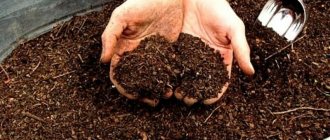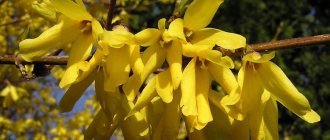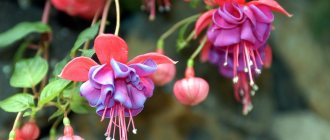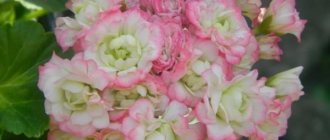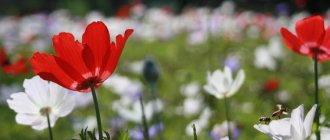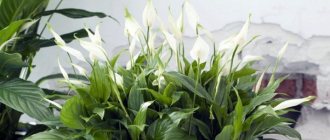The herbaceous plant Waller's balsam, or Waller's balsam (Impatiens walleriana), which is also called “impatiens,” is part of the Impatiens family. The bush reaches a height of approximately 0.6 m. Its shoots are decorated with pale red or dark green alternately arranged leaf plates. They are quite wide and have a serrated edge.
This plant comes from Asia and Africa, and it prefers to grow in areas with a tropical climate. Waller's balsam came to America and Europe in 1596. Its single flowers can be simple or double. They have a rich color, which can be very different (except for blue and yellow shades). When the flower fades, a fruit-box forms in its place. After ripening, it opens easily and many small seeds spill out.
Impatiens is a fast-growing perennial plant that has a very long flowering period. Bushes grown from seeds begin to bloom already in the third month of growth.
Botanical description and history
Impatiens originate from the forests of Asia and Africa. These are heat-loving plants that love moisture. Waller's balsam (Impatiens walleriana) has long been grown as a houseplant. People call it Vanka wet (there are small drops of moisture at the tips of the leaves) and Impatiens (when touched, it “scatters” seeds).
In general, Waller's balsams are classic, just those that grow on window sills, and hybrid ones, suitable for flower beds. The latter are short-growing (15-30 centimeters), richer in color and bloom more profusely. They can withstand fluctuations in temperature and humidity and can tolerate heat in a flower garden. They can also grow at home, blooming on a bright windowsill even in winter.
Reference! Hybrids can be purchased at garden centers and look good in hanging planters for decoration.
Varietal diversity
Among the popular varieties of Waller's balsam, experienced gardeners distinguish:
Carnival soft pink. The dimensions of the compact hybrid variety are only 20 cm
Impatiens attracts attention with its dark green leaves and large pink flowers. Due to its long flowering, it is often chosen for decorating garden beds and terraces.
Carnival lavender. The low-growing annual plant (height 20 cm) has flowers of a soft lavender hue and is flat-open. The leaf blades are a rich dark green color. Impatiens are known for their long-lasting blooms and are also good for garden decoration. It looks especially impressive in outdoor flowerpots and flowerpots. Temptation orange. The annual Temptation orange produces fairly large flowers, they are double and orange in color. The plant has a spherical shape, its height does not exceed 30 cm, and its diameter is 15 cm. Temptation also has light pink flowers, which are 4 cm in diameter. The flowering phase begins in June and lasts until frost. Similar characteristics are seen in Temptation, which has light purple flowers. Stardust. The bush is compact in size and easy to care for. A special feature of the variety is the presence of a white spot in the center of the flower. Symphony. The height of the low-growing bush is 20 cm. Its flowers are large with a matte tint. This series of balsams is distinguished by its early flowering period. Futura. This terry ampelous balsam grows up to 30 cm, its shoots are highly branched. The early flowering variety produces flowers of bright colors, their diameter is 4-5 cm. The plant looks especially advantageous in hanging pots and high floor flowerpots. Super Elfin. This series includes 13 varieties of corolla. The height of the bush is 20-25 cm, its dimensions are compact, which does not create difficulties in care and cultivation. King Kong. Balsam grows up to 30 cm, its flowers are large and brightly colored, their diameter is 5-6 cm. The bush is distinguished by abundant and long flowering, the corolla comes in different shades. Novett. This miniature bush does not exceed 15 cm in height. The plant is able to delight with its original flowering throughout the entire growing season, from spring to autumn. Duet. This variety is popular due to its voluminous double flowers. Candy. The series includes 17 varieties of balsam. The flowers are simple, varied in color.
Waller's balsam (Waller) has a wide range of colors, which allows you to create incredibly beautiful compositions both at home and in the garden.
Description of appearance and features
This is a perennial (in warm regions) bush plant with a height of 20 to 60 centimeters. It has erect, succulent stems, strongly branched. The leaves are wide, large, oval in shape, pointed towards the end, with jagged edges and light green in color.
Their length is about 10 centimeters. The flowers are 4 centimeters in diameter, either solitary or collected in few-flowered inflorescences. The pedicels are long. themselves can be simple or double and of different shades (usually red or pink).
Hybrids are smaller in height - from 15 to 30 centimeters, branch more strongly, produce more flowers, varied in shades. It grows quickly, blooms early and decorates the garden all summer long. Quite unpretentious, can grow in relative shade.
Photo of an indoor flower – Vanka wet
Next you can see what Waller's balsam looks like in the photo.
This beautiful flower is very popular among gardeners. If you decide to grow such a long-flowering and unpretentious plant, then you may be interested in learning more about it. On our website you will find a lot of information about the following types and varieties of this plant: Wild, Zheleznokosny or Zhelezisty, New Guinea and Tom Samb. We also talked separately about hanging varieties of balsam.
Growing difficulties
This species has certain problems. The most common problems with Waller's Impatiens are listed below .
- Small, pale leaves. elongated stems. Lack of nutrients, cramped pot, high temperature, lack of lighting.
- Leaves fall, curl, stems rot. Dampness, low temperature.
- The leaves dry out and fall off. Dry air, high temperature.
- Loss of color in leaves. Lack of lighting.
- Weak flowering or its complete absence. Lack of lighting, nutrients or excess fertilizers, especially nitrogenous ones.
- Stop flowering. Frosts, cold snaps, dry soil, too large a pot, incorrectly chosen time of replanting.
All these troubles can be dealt with if you pay attention to the condition of the plant in time and take action.
Rules and advice on landing conditions
is considered difficult to grow from seed . Indeed, they need to be sown in January or mid-March, if you are sure of the quality, in sand or a mixture with peat, under mandatory additional lighting. Moreover, the seeds are placed on the surface of the soil, slightly pressed into it, and the top of the pot should be covered with film for better germination.
It is important to shake off the condensation from it so that they do not get fungal diseases. The temperature should be room temperature, about 25 degrees. The germination process takes from 7 to 14 days, during which it is important to control humidity and ventilate the seedlings. To prevent them from stretching, you need to reduce the temperature to 17 degrees.
Grown-up seedlings of Waller's balsam are transferred to open ground in June , when the likelihood of frost for herbaceous plants disappears.
Reference! It can also be grown from cuttings taken in the fall. They are grown in pots as houseplants, and can be replanted in the spring or left at home if desired. The requirements for soil and conditions are similar.
Lighting and location
They grow well both in partial shade and in sunny areas. True, it is better not to plant it in direct sunlight, where the plant can get leaf burns. Heat-loving, does not tolerate temperatures below 5 degrees. The best landing place is on a slope where the sun lingers for a couple of hours a day, no more. If Waller's balsam grows at home, then choose any window direction except south. The temperature should not fall below 22-25 degrees.
Soil requirements
Loves light, fertile soils . Does not tolerate excess moisture, so moderation is important. It is better to water in the evening so as not to burn the leaves. When growing at home, you should not forget about fertilizing the soil with fertilizers, but in moderation and not too often.
Garden balsam
Impatiens are well compatible with other annual flowers.
Impatiens love a lot of watering.
Impatiens are not particularly demanding on lighting and can grow in partial shade or full sun. But too intense sunlight can negatively affect the flowering of the plant, so it is better to plant it on the eastern side. There are also no special requirements for the soil, but it is clear that the more fertile it is, the more extensive and beautiful the flowering will be.
Impatiens love warmth, so even at a temperature of +8°C the plant can get sick and die. For this reason, planting in open ground is carried out during a period of consistently high temperatures.
In order for balsam to grow quickly, it needs to be watered regularly. This plant loves moisture very much, so in drought conditions its shoots can quickly wither.
To ensure long flowering, it is recommended to feed balsam once every 2 weeks. It is best to use foliar fertilizing, but you should avoid nitrogen fertilizers.
Impatiens are prone to insect damage, so it must be sprayed to prevent the appearance of mites.
To do this, you can use tobacco infusion, as well as infusion of onion peels, garlic and other preparations of natural or chemical origin.
Care at home and in the open ground
Waller's balsam is quite unpretentious and does not require much care. The soil should always be moist, but not excessively. In winter, watering for potted bushes is reduced and done after the soil has dried. The leaves can be sprayed, the main thing is not during direct exposure to the sun. Fertilize from March to September once every two weeks if the flower is planted in open ground.
It is important to remember that stems and leaves are especially fragile due to moisture saturation , so they should grow either next to each other, as support from the wind, or in windless areas of the garden. It is better to remove faded buds to maintain a beautiful appearance and allow new ones to bloom freely.
In the fall, before frost, garden balsams of this variety are covered, and the pots are brought into a warm room. It is not advisable to transplant from the garden into a container; it is better to root the cuttings for subsequent cultivation from them.
Popular varieties
Thanks to the work of breeders, Waller's balsam today has a huge number of hybrids, differing in the shape and color of the leaves, the color of the buds and the size of the bush.
| Variety/group of varieties | Description |
| Stardust | a small plant whose flowers have a white spot in the center |
| Symphony | several varieties of balsam, characterized by their small size (up to 20 cm) and having a variety of colors |
| Futura | a group of hanging varieties with climbing stems and bright flowers |
| Starflake Rose | plants with pale green leaves and lavender buds that grow to medium size |
| Fanciful Tropical | coral or salmon color of buds, terry surface of petals |
| Stardust Lavender | the buds of this variety resemble roses and have a pinkish-lavender color with a silvery tint |
| Super Elfin | shrubs up to 25 cm in height, 13 color options |
| Novette | miniature flower growing up to 15 cm |
| King Kong | 30-centimeter plant with large bright buds |
| Fiesta | a group of varieties, about 30 cm high with a variety of colors |
| Orange temptation | has double orange flowers |
There are other types of balsam, including those bred in Russia. Among them, the most famous are:
- "Scarlett" with large bright red flowers;
- “Strawberries and cream” with double petals and red and white color;
- “Metallic pink”, which has large pink buds;
- “Apple blossom” with large velvety soft pink petals;
- “Cherry Dream” with cherry blossoms;
- “Flash” with two-color white and pink buds;
- "Sweet Dream" with peachy pink flowers.
Features of reproduction
The plant is mainly grown from seeds . Take fresh, high-quality seeds. They are not used from hybrids, as they will not give the properties of the parents. It is also propagated by cuttings, which take root within one to two weeks.
Do not allow high salt content in the soil and maintain optimal humidity and light for the variety. You can grow a home bush from cuttings without any problems. This method is more preferable for beginner gardeners due to its greater simplicity.
Waller's balsam is a beautiful and long-flowering plant that can decorate any garden or home . Its unpretentiousness and relative ease of care have allowed it to become so popular among gardeners. Impatiens of this variety will give only positive impressions and will definitely become one of your favorites among other plants.
We invite you to watch a video about propagating Waller's balsam from seeds:
How to properly care?
You already have an idea of how to grow balsam. But in addition to the basic technology of seed propagation, you also need to familiarize yourself with information on how to care for shrubs. The specialized literature says that the plant is a moisture-loving plant. But experienced gardeners say that excessive watering is very dangerous. They can lead to rotting of the root system and death of the flower. Therefore, they are not done too often, periodically spraying the leaves with water from a spray bottle.
Mandatory procedures are fertilizing. Without them, flowering will be short and sparse. Fertilizers are applied to the soil at the end of spring, while buds have not yet appeared on the shoots. It is best to use complex mineral mixtures with a high nitrogen content. As soon as the flowering period begins, they switch to potassium and phosphorus fertilizers, which are added to the plants for two weeks, after which they are stopped.
Since balsam belongs to the group of annual plants, rejuvenation is not required. The crown of the bushes is very lush and has the correct shape, so even without pruning it looks very attractive and decorative.



